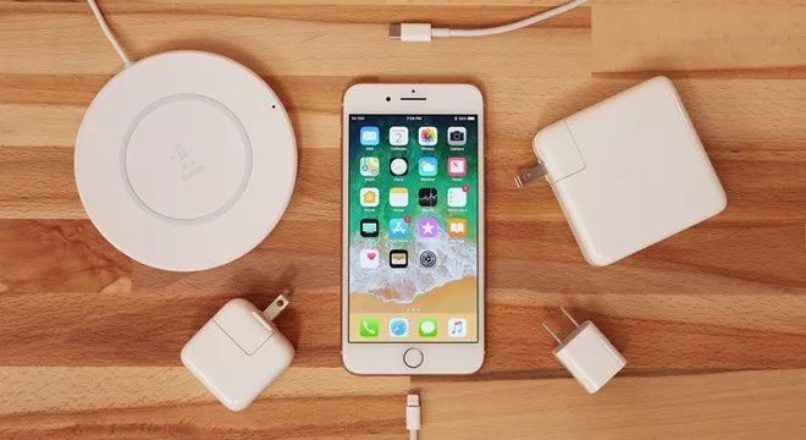
Who Is Better In Cable Charger VS Wireless Charging
With the continuous increase of artificial intelligence and mobile devices, a variety of electronic devices have emerged at the historic moment. And the charging devices of relative products are also very abundant. Various types of charging cables, chargers, adapters, and charging piles have become commonplace, and the wireless charger has also entered people’s sight.
Many people are still entangled. Charger or wireless charging which is better?Should I use wireless charger instead of Cable charging? Now, let me show you which is the best choice.
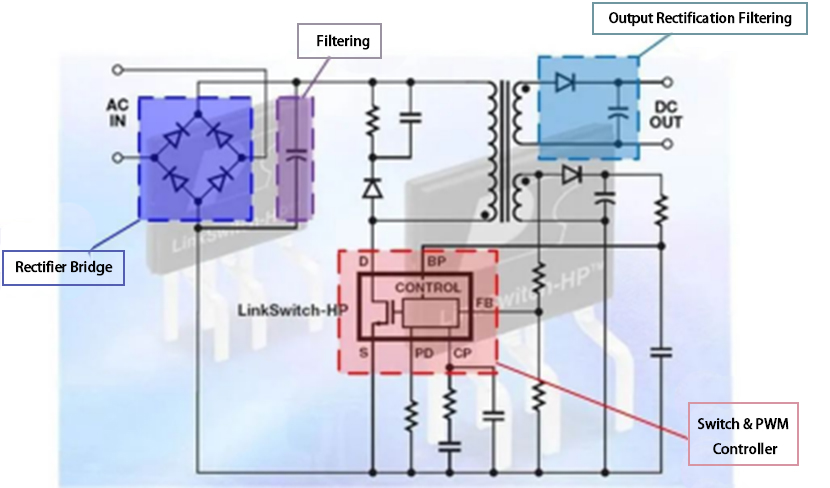 Larger charging devices, such as car charging piles, work similarly to ordinary adapters.But in addition to basic AC-DC, there are billing control units, charging controllers, insulation detection modules, displays, and electricity meters. Lightning protection and other modules, between different modules, the charging pile and BMS also need to communicate through the CAN bus to ensure the safety of the entire charging. The core module of the charging pile-the power module of the charger, its principle is similar to the AC-DC circuit board in the figure above.
Larger charging devices, such as car charging piles, work similarly to ordinary adapters.But in addition to basic AC-DC, there are billing control units, charging controllers, insulation detection modules, displays, and electricity meters. Lightning protection and other modules, between different modules, the charging pile and BMS also need to communicate through the CAN bus to ensure the safety of the entire charging. The core module of the charging pile-the power module of the charger, its principle is similar to the AC-DC circuit board in the figure above.
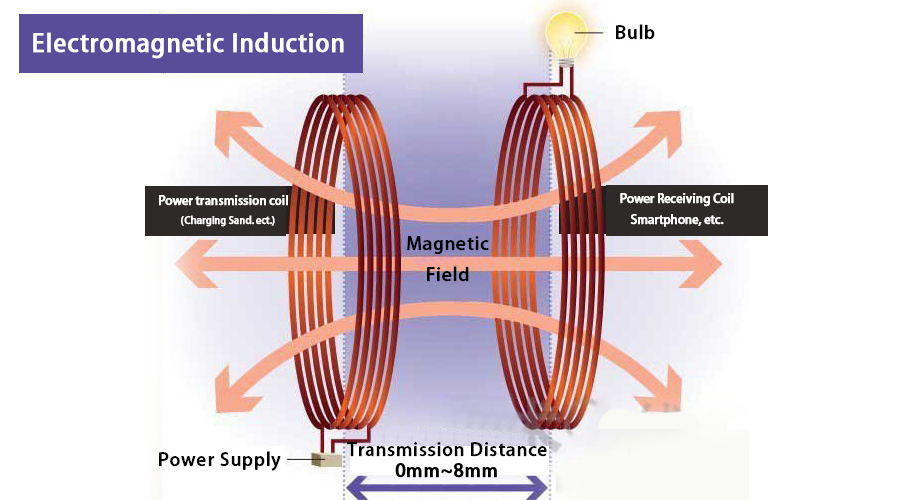 Applying this principle to a mobile phone, there is a primary coil in the charging base, and a secondary coil is built in the mobile terminal. Because of electromagnetic induction. When the mobile phone is close to the charging base, the mobile phone’s receiving coil will generate a certain current to charging the mobile phone without a charging cable.
However, electromagnetic induction wireless charging technology also has great shortcomings. The most troublesome of which is the limited transmission distance. At present, the effective charging distance of this technology is only 10mm, and if the two coil positions are not aligned, problems may also occur.
Applying this principle to a mobile phone, there is a primary coil in the charging base, and a secondary coil is built in the mobile terminal. Because of electromagnetic induction. When the mobile phone is close to the charging base, the mobile phone’s receiving coil will generate a certain current to charging the mobile phone without a charging cable.
However, electromagnetic induction wireless charging technology also has great shortcomings. The most troublesome of which is the limited transmission distance. At present, the effective charging distance of this technology is only 10mm, and if the two coil positions are not aligned, problems may also occur.
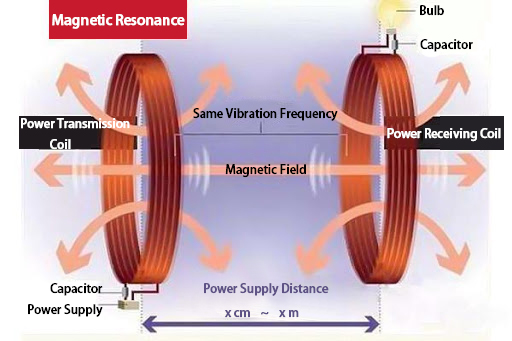 The magnetic vibrator is consists of a large inductance coil with small capacitors connected in parallel or series. In contrast to electromagnetic induction, magnetic resonance wireless charging has a longer transmission distance, higher power supply efficiency, and supports one-to-many power supply. But the biggest difficulty is: how to make two circuits get the same frequency, frequency modulation is the core step in this technology.
The magnetic vibrator is consists of a large inductance coil with small capacitors connected in parallel or series. In contrast to electromagnetic induction, magnetic resonance wireless charging has a longer transmission distance, higher power supply efficiency, and supports one-to-many power supply. But the biggest difficulty is: how to make two circuits get the same frequency, frequency modulation is the core step in this technology.
 There are two main ports in the radio wave power transmission system, microwave transmitting device and a microwave receiving device. The microwave transmitting device emits radio waves. And the microwave receiving device captures the radio wave energy and adjusts it with the load to obtain stable direct current.
Theoretically, the transmission distance of this wireless charging method is far longer than that of the electromagnetic induction method and the magnetic resonance method, up to more than 10 meters. And it can also realize automatic charging anytime, anywhere. However, this method also has a great disadvantage, which is a relatively low transmission efficiency.
There are two main ports in the radio wave power transmission system, microwave transmitting device and a microwave receiving device. The microwave transmitting device emits radio waves. And the microwave receiving device captures the radio wave energy and adjusts it with the load to obtain stable direct current.
Theoretically, the transmission distance of this wireless charging method is far longer than that of the electromagnetic induction method and the magnetic resonance method, up to more than 10 meters. And it can also realize automatic charging anytime, anywhere. However, this method also has a great disadvantage, which is a relatively low transmission efficiency.
Principles & Types of Charger
The method of Cable charging is no stranger to everyone. We often use Cable chargers on many occasions in daily life. Such as mobile phone chargers, computer adapters, battery car charging stations, electric vehicle charging piles, and so on. There is nothing mysterious about the principle of cable charging. The basic principle is an AC-DC power circuit, as shown in the figure below. The circuit often consists of rectifier bridges, filter circuits, switches and PWM controllers, and output rectification and filtering composition. According to the requirements of different power and different voltage output, adjust the device parameters in the circuit, PWM control, output ratio, etc. Larger charging devices, such as car charging piles, work similarly to ordinary adapters.But in addition to basic AC-DC, there are billing control units, charging controllers, insulation detection modules, displays, and electricity meters. Lightning protection and other modules, between different modules, the charging pile and BMS also need to communicate through the CAN bus to ensure the safety of the entire charging. The core module of the charging pile-the power module of the charger, its principle is similar to the AC-DC circuit board in the figure above.
Larger charging devices, such as car charging piles, work similarly to ordinary adapters.But in addition to basic AC-DC, there are billing control units, charging controllers, insulation detection modules, displays, and electricity meters. Lightning protection and other modules, between different modules, the charging pile and BMS also need to communicate through the CAN bus to ensure the safety of the entire charging. The core module of the charging pile-the power module of the charger, its principle is similar to the AC-DC circuit board in the figure above.
What Is Wireless Mobile Charging
Wireless charging is an application of wireless energy transmission technology. The energy between the charger and the electric device transfer by the magnetic field. There is no wire connecting the two so that they can transmit electrical energy without the conductive contacts being exposed.How does a wireless phone charger work
There are currently 3 technical operations that can implement the function of wireless charging.1.Electromagnetic Induction Wireless Charging
Electromagnetic induction wireless charging technology uses the principle of electromagnetic induction, which is also the most popular and extensive use in wireless charging technology. There are two main coils in this charging system: A primary coil and a secondary coil. First, a certain frequency of the alternating current is pass to the primary coil. Due to the effect of electromagnetic induction, the secondary coil will generate certain current. So energy is transfer from the transmitting end to the receiving end. Applying this principle to a mobile phone, there is a primary coil in the charging base, and a secondary coil is built in the mobile terminal. Because of electromagnetic induction. When the mobile phone is close to the charging base, the mobile phone’s receiving coil will generate a certain current to charging the mobile phone without a charging cable.
However, electromagnetic induction wireless charging technology also has great shortcomings. The most troublesome of which is the limited transmission distance. At present, the effective charging distance of this technology is only 10mm, and if the two coil positions are not aligned, problems may also occur.
Applying this principle to a mobile phone, there is a primary coil in the charging base, and a secondary coil is built in the mobile terminal. Because of electromagnetic induction. When the mobile phone is close to the charging base, the mobile phone’s receiving coil will generate a certain current to charging the mobile phone without a charging cable.
However, electromagnetic induction wireless charging technology also has great shortcomings. The most troublesome of which is the limited transmission distance. At present, the effective charging distance of this technology is only 10mm, and if the two coil positions are not aligned, problems may also occur.
2.Magnetic Resonance Wireless Charging
On June 7, 2007, the MIT research team published results in “science”, stating that it successfully “grabbed” electromagnetic waves. They used copper coils as electromagnetic resonance devices. After the sender sent electromagnetic waves of a specific frequency, they spread to the receiver through the electromagnetic field and successfully powered a 60-watt light bulb two meters away. Therefore, two devices are needed to use this charging. An energy transmitting device and an energy receiving device. The condition for achieving energy transmission is that the two devices need to be adjusted to the same frequency. For example, two coils are used as resonators. The transmitting end emits electromagnetic fields to the surroundings at a frequency of 10 MHz, and the receiving end also needs to vibrate at 10 MHz to achieve energy transmission. The magnetic vibrator is consists of a large inductance coil with small capacitors connected in parallel or series. In contrast to electromagnetic induction, magnetic resonance wireless charging has a longer transmission distance, higher power supply efficiency, and supports one-to-many power supply. But the biggest difficulty is: how to make two circuits get the same frequency, frequency modulation is the core step in this technology.
The magnetic vibrator is consists of a large inductance coil with small capacitors connected in parallel or series. In contrast to electromagnetic induction, magnetic resonance wireless charging has a longer transmission distance, higher power supply efficiency, and supports one-to-many power supply. But the biggest difficulty is: how to make two circuits get the same frequency, frequency modulation is the core step in this technology.
3.Radio Wave Transmission
The principle of transmitting electricity by radio waves is to convert electromagnetic waves into electric currents and then transmit the electric current through the circuit. There are two main ports in the radio wave power transmission system, microwave transmitting device and a microwave receiving device. The microwave transmitting device emits radio waves. And the microwave receiving device captures the radio wave energy and adjusts it with the load to obtain stable direct current.
Theoretically, the transmission distance of this wireless charging method is far longer than that of the electromagnetic induction method and the magnetic resonance method, up to more than 10 meters. And it can also realize automatic charging anytime, anywhere. However, this method also has a great disadvantage, which is a relatively low transmission efficiency.
There are two main ports in the radio wave power transmission system, microwave transmitting device and a microwave receiving device. The microwave transmitting device emits radio waves. And the microwave receiving device captures the radio wave energy and adjusts it with the load to obtain stable direct current.
Theoretically, the transmission distance of this wireless charging method is far longer than that of the electromagnetic induction method and the magnetic resonance method, up to more than 10 meters. And it can also realize automatic charging anytime, anywhere. However, this method also has a great disadvantage, which is a relatively low transmission efficiency.
Cable Charger vs Wireless Charging
Cable Charger
- Disadvantage: Because the charging device must be in contact with the electronic device, there must be a plug and socket structure. Therefore, the phenomenon that charging cannot be performed without a corresponding charging interface often occurs, which is inconvenient to use. In addition, it is easy to produce sparks, leakage, and wear. And the contacts may heat up, catch fire, and have limited power.
- Advantage: However, cable charging has high power conversion efficiency, mature product testing, and a wide range of applications. Cable charging is still the current main charging method.
Wireless Charging
- Advantage: The wireless charger can charge the device without direct contact. It is easy to use and has strong environmental adaptability. It avoids physical interfaces, so there is no interface wear, sparks, leakage, etc. In addition, wireless charging can also achieve high voltage and high current. High-power charging.
- Disadvantage: Due to technical reasons, the transmission distance of most wireless chargers can only reach tens of millimeters. Especially the power conversion efficiency and efficiency of the wireless part are also a big problem. Taking the most popular 10W wireless charger as an example, it takes about 2.5 hours to fully charge an iPhone X at a charge conversion rate of 75%. According to the ZDNet wireless charging test report, wireless charging has an impact on the battery life of mobile phones. And the battery ageing rate for long-term wireless charging may increase by 50%.
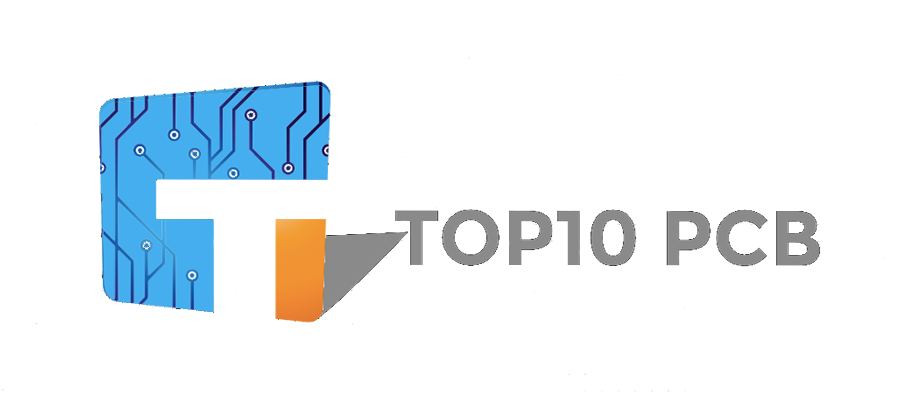
Comment ( 1 )
[…] charging systems using magnetic field coupling technology have been around since the late 1800s, but it is only recently that recent advances in components, […]